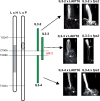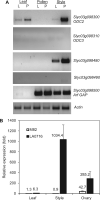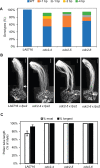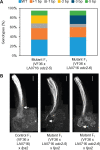Ornithine decarboxylase genes contribute to S-RNase-independent pollen rejection
- PMID: 33576789
- PMCID: PMC8154068
- DOI: 10.1093/plphys/kiab062
Ornithine decarboxylase genes contribute to S-RNase-independent pollen rejection
Abstract
Unilateral incompatibility (UI) manifests as pollen rejection in the pistil, typically when self-incompatible (SI) species are pollinated by self-compatible (SC) relatives. In the Solanaceae, UI occurs when pollen lack resistance to stylar S-RNases, but other, S-RNase-independent mechanisms exist. Pistils of the wild tomato Solanum pennellii LA0716 (SC) lack S-RNase yet reject cultivated tomato (Solanum lycopersicum, SC) pollen. In this cross, UI results from low pollen expression of a farnesyl pyrophosphate synthase gene (FPS2) in S. lycopersicum. Using pollen from fps2-/- loss-of-function mutants in S. pennellii, we identified a pistil factor locus, ui3.1, required for FPS2-based pollen rejection. We mapped ui3.1 to an interval containing 108 genes situated on the IL 3-3 introgression. This region includes a cluster of ornithine decarboxylase (ODC2) genes, with four copies in S. pennellii, versus one in S. lycopersicum. Expression of ODC2 transcript was 1,034-fold higher in S. pennellii than in S. lycopersicum styles. Pistils of odc2-/- knockout mutants in IL 3-3 or S. pennellii fail to reject fps2 pollen and abolish transmission ratio distortion (TRD) associated with FPS2. Pollen of S. lycopersicum express low levels of FPS2 and are compatible on IL 3-3 pistils, but incompatible on IL 12-3 × IL 3-3 hybrids, which express both ODC2 and ui12.1, a locus thought to encode the SI proteins HT-A and HT-B. TRD observed in F2 IL 12-3 × IL 3-3 points to additional ODC2-interacting pollen factors on both chromosomes. Thus, ODC2 genes contribute to S-RNase independent UI and interact genetically with ui12.1 to strengthen pollen rejection.
© American Society of Plant Biologists 2021. All rights reserved. For permissions, please email: journals.permissions@oup.com.
Figures








Similar articles
-
Genetic interactions and natural variation underlying S-RNase-independent unilateral incompatibility in Solanum.Plant J. 2025 Aug;123(4):e70412. doi: 10.1111/tpj.70412. Plant J. 2025. PMID: 40839807
-
A farnesyl pyrophosphate synthase gene expressed in pollen functions in S-RNase-independent unilateral incompatibility.Plant J. 2018 Feb;93(3):417-430. doi: 10.1111/tpj.13796. Epub 2018 Jan 7. Plant J. 2018. PMID: 29206320
-
HT proteins contribute to S-RNase-independent pollen rejection in Solanum.Plant J. 2017 Feb;89(4):718-729. doi: 10.1111/tpj.13416. Epub 2017 Feb 10. Plant J. 2017. PMID: 27862494
-
S-RNase complexes and pollen rejection.J Exp Bot. 2003 Jan;54(380):123-30. doi: 10.1093/jxb/erg045. J Exp Bot. 2003. PMID: 12456762 Review.
-
Compatibility and incompatibility in S-RNase-based systems.Ann Bot. 2011 Sep;108(4):647-58. doi: 10.1093/aob/mcr179. Epub 2011 Jul 28. Ann Bot. 2011. PMID: 21803740 Free PMC article. Review.
Cited by
-
Gene expression and pollen performance indicate altered postmating selection between Solanum species with different mating systems.G3 (Bethesda). 2025 Jul 9;15(7):jkaf107. doi: 10.1093/g3journal/jkaf107. G3 (Bethesda). 2025. PMID: 40372153 Free PMC article.
-
Genetic basis for broad interspecific compatibility in Solanum verrucosum.Plant J. 2025 Aug;123(4):e70426. doi: 10.1111/tpj.70426. Plant J. 2025. PMID: 40836693 Free PMC article.
-
A Cysteine-Rich Protein, SpDIR1L, Implicated in S-RNase-Independent Pollen Rejection in the Tomato (Solanum Section Lycopersicon) Clade.Int J Mol Sci. 2021 Dec 2;22(23):13067. doi: 10.3390/ijms222313067. Int J Mol Sci. 2021. PMID: 34884871 Free PMC article.
-
Molecular mechanisms and genetic regulation of self-incompatibility in flowering plants: implications for crop improvement and evolutionary biology.Plant Mol Biol. 2025 Jun 25;115(4):76. doi: 10.1007/s11103-025-01610-9. Plant Mol Biol. 2025. PMID: 40560319 Review.
-
The Effect of Self-Compatibility Factors on Interspecific Compatibility in Solanum Section Petota.Plants (Basel). 2023 Apr 20;12(8):1709. doi: 10.3390/plants12081709. Plants (Basel). 2023. PMID: 37111931 Free PMC article.
References
-
- Aloisi I, Distefano G, Antognoni F, Potente G, Parrotta L, Faleri C, Gentile A, Bennici S, Mareri L, Cai G, Del Duca S (2020) Temperature-dependent compatible and incompatible pollen-style interactions in Citrus clementina Hort. ex Tan. Show different transglutaminase features and polyamine pattern. Front Plant Sci 11: 1018. - PMC - PubMed
-
- Alseekh S, Ofner I, Pleban T, Tripodi P, Di Dato F, Cammareri M, Mohammad A, Grandillo S, Fernie AR, Zamir D (2013) Resolution by recombination: breaking up Solanum pennellii introgressions. Trends Plant Sci 18: 536–538 - PubMed
-
- Baek YS, Covey PA, Petersen JJ, Chetelat RT, McClure B, Bedinger P (2015) Testing the ‘SI × SC rule’: pollen–pistil interactions in interspecific crosses between members of the tomato clade (Solanum section Lycopersicon, Solanaceae). Am J Bot 102: 1–10 - PubMed
Publication types
MeSH terms
Substances
LinkOut - more resources
Full Text Sources
Other Literature Sources
Miscellaneous

